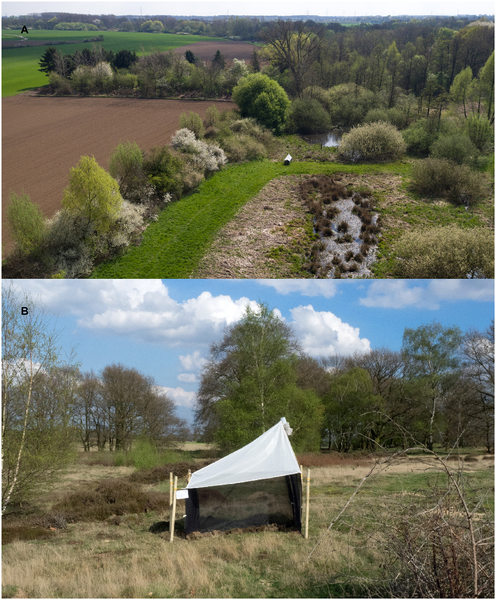A research group concludes that the biomass of insects have declined by over 75 % in the last 27 years!
A research group from the Radboud University in The Netherlands and the Entomological Society Krefeld in Germany have worked on a 27 year long project to map the biomass of insects in 63 different nature reserves in Germany, and the results have finally been published in PLOS One.
And the conclusion from the project is shocking! The researchers report that the biomass of insects have declined by more than 75 % during this 27 year time period. During the summer, when most insects are usually found, a 82 % biomass decline was witnessed, which means that over 4/5 of the biomass of insects that were present 30 years ago are no longer found. This has been seen on a smaller scale already, but this project goes a long way to show us that this problem is huge, and happens rapidly.

An aerial overview of one of the sampling sites for the project, as well as a close-up for the sampling tent used to capture the insects. Image by Hallmann CA, Sorg M, Jongejans E, Siepel H, Hofland N, Schwan H, et al. Posted with the Creative Commons License Attribution 4.0 International
Remember that we are talking about the biomass
It is important to remember that we are talking about biomass, and not individuals or species. The biomass is the total mass of a certain community or population, and the mass of each individual contributes with different amount of biomass. For example, butterflies typically only contributed a few grams each, while larger beetles and other bigger insects could contribute 5+ grams each. This means that we can’t really know which species have lost the highest numbers of individuals, but it gives a rough estimate to how the insects are doing in general.
Why is this happening?
The decrease in biomass of insects is not something new, but this is the first time that is has been documented on such a large scale. Up until now most studies have been focusing on the decline of certain species, but this research focuses on every single insect that are found in the parks where they did the measurements.
The exact reason why the insects are in decline is not really known for certain, but there are many theories out there. These includes reasons such as toxic pollutants in the air, which we to some degree got in many places, reduced habitat, or reduction in the different species of plants for the insects to graze upon. The reason of the decline is also not really what the research was about, it was more about documenting the decline, and see how much the decline would differ from the expected amount.
The insects are important!
While insects might not really seem all that useful at first glance, they are extremely important for ecological processes. Without insects we would not be able to pollinate flowers, which would lead to a lot of the food sources we now have to go away. I don’t exaggerate when I say that we would be facing a huge threat to our survival of the pollinators disappear.
Other insects provide other ecosystem services such as breaking down dead organic material into smaller molecules so that it can be reused by other organisms. They are also extremely important in the food web, where many species are dependent on eating them to live. If insects were to disappear entirely, we would most likely not survive for long!
A good thing about research papers like this one is that it documents how big the problem is. This allows us to see the problem for what it is, and work on creating solutions to solve it. Saving the insects might be difficult since there is no single clear cause of the problem, but at least this will allow scientists to address the issues we are facing. Hopefully we can find some solutions that will stop the decline in insect biomass in the future!
Thanks for reading
Thanks for reading my post about the decline of insect biomass. If you want to know more, then check out the research paper at PLOS One. These often tend to be very expensive to read, but this one can be red for free! So don’t miss the opportunity to take a closer look for yourself.
About the author
Hi, I’m @valth! I live in Norway with my wife, our baby, and our two dogs; one of which is seen wearing a bow tie in the profile picture!
I am very passionate about nature and biology, and have been studying ecology for a few years now. My passions are mostly within conservation biology, mycology (the studies of mushrooms), botany, animal behavior and general microbiology. I really enjoy both the theoretical aspect, as well as the more practical aspect of biology, and I spend about as much time in front of biology textbooks as I do spend on finding and identifying plant, mushroom and animal species in the forests.
The importance of this cannot be overstated, I wrote about it myself, but you did a better job.
As a follower of @followforupvotes this post has been randomly selected and upvoted! Enjoy your upvote and have a great day!
Than you for posting. This is a bit scary.
let us not underestimate the fact that humans like to kill insects, not only those in their houses, but pretty much everywhere they go, and if we know something about us is how proficient we are at killing